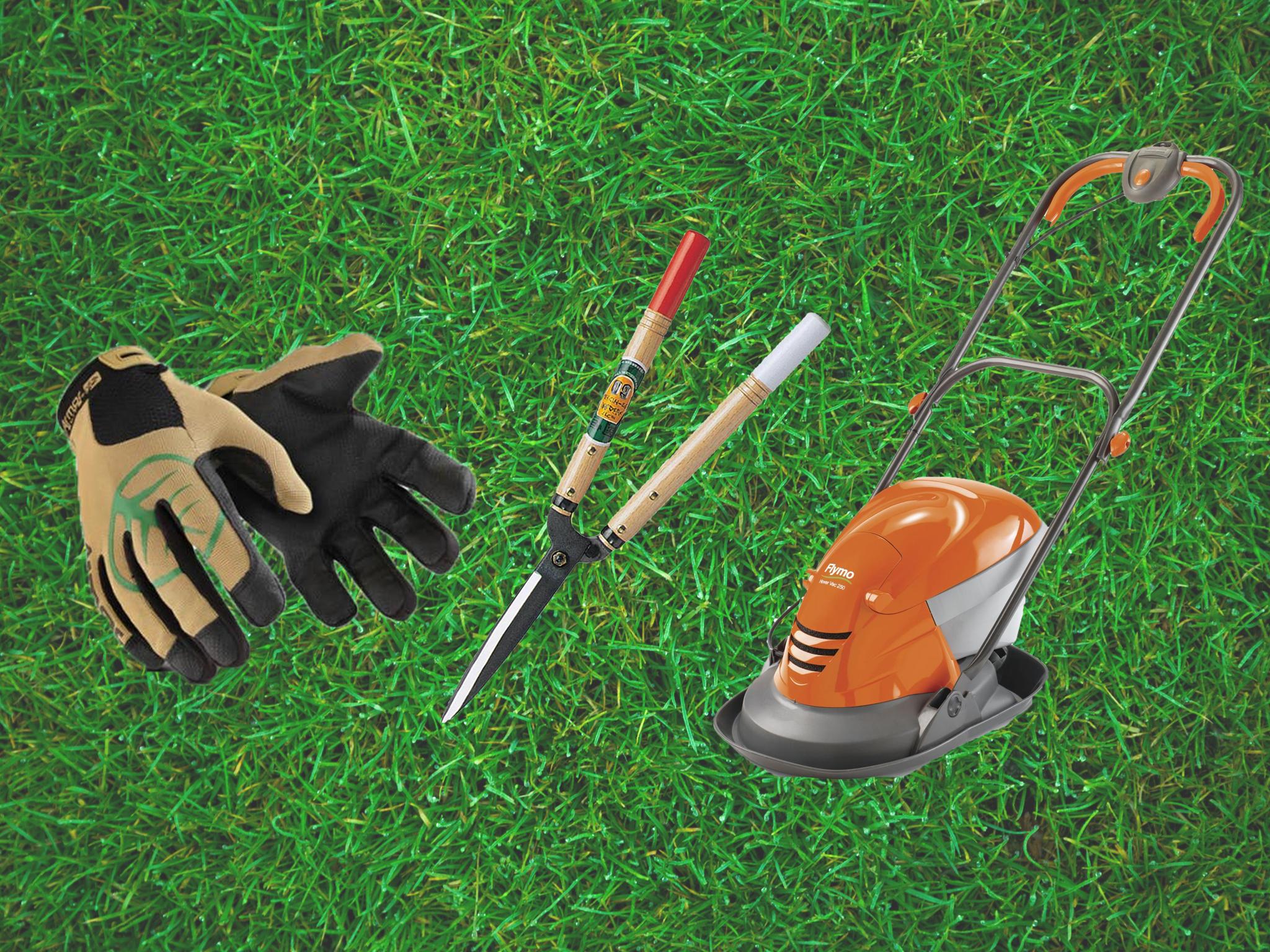The Independent's journalism is supported by our readers. When you purchase through links on our site, we may earn commission. Why trust us?
Garden centres reopening: Tips to maintain your green space from weeding to mowing
Stay on top of overgrown hedges, unruly lawns and re-potting with these easy tips

The ongoing lockdown has seen many people get stuck into gardening. And as garden centres have reopened as of 13 May, we’re sure it’ll only continue. You can find out all the details on gardening centres here.
Whether you’re growing your own vegetables to be more self dependent, beginning to cultivate a balcony or windowsill garden, or want to get your space ready for summer, we’ve got you covered.
But if you’ve painstakingly taken the time to create perfect lawns, colourful flower beds and vegetable patches, it’s important to keep it looking its best with a lawnmower, shears, frost protection and weeding tools.
Staying on top of garden maintenance means you can enjoy the fruits of your labour for longer and get the best harvest from herbs and vegetables. Here are our top tips.
You can trust our independent round-ups. We may earn commission from some of the retailers, but we never allow this to influence selections. This revenue helps us to fund journalism across The Independent.
Vegetable growing
You don’t need a huge garden spanning acres to successfully grow your own produce. If you need anymore inspiration to get growing and get out in whatever space you have, visit our gardening section here.
In our guide to growing vegetables at home, even if you don’t have a garden, we explain what you can grow depending on the space you have, from herbs in windowsills to asparagus in a a greenhouse.
If you already planted potatoes in April, which the first harvest will be ready to eat this month, which is the best time to start earthing and plant any you may have remaining.
The RHS recommends using a fork to carefully lift them when they’re ready when tubers are about the size of a hen’s egg or more.
“Flowering often occurs at this time, but the tubers may be ready before. Provided the crop is healthy, leave the main crop plants until early to mid-autumn to bulk up,” it reads on its website.
A late spring frost can do damage to tender plants and vegetables such as tomatoes, daffodils and dahlias.
To fend off night frosts in May that often continue into the north of the UK into early June, Guy Barter, chief horticulturist for the RHS advises covering your plants overnight with newspaper or horticultural fleece.
Come June, harvest your lettuce and radishes and prune spring-flowering shrubs. Find the RHS guide to sowing vegetables you’ve planted here.
Once flowers start showing on any shrubbery you have, that’s the best time to start pruning them. According to the RHS, pruning immediately after flowering allows the maximum time for development of young growth to provide the following year’s flowers before the end of summer.
On its website, it details a step by step guide to pruning successfully, find it here.
Weeding
First things first, protect your hands when you're getting stuck into planting into the soil with a pair of gardening gloves. These are especially important as increased hand washing can leave skin feeling sensitive.
Try the Hexarmour thornarmour 3092 gardening and landscaping gloves (Safety Gloves, £36.27) which will stop you getting stung by prickly weeds or thorns and won’t allow any soil to get inside either.
Throughout May and June, the RHS recommends hoeing weeds regularly to keep them at bay. Simply run a hoe such as this Nejiri gama hoe (Amazon, £16.99) over a bed or between rows of plants to kill weed seedlings.
The blade is made from hardened steel and it comes with a hanging loop on its wooden handle to easily stow it away when you’re finished with it.
The RHS suggests doing this on a dry day with light wind, so that the seedlings will dry out on the surface of the bed rather than re-rooting into moist soil.
If you’re going to be re-potting plants and putting new ones into beds, you'll need a trowel.
Taking the top spot in our IndyBest guide to the best garden trowels was the Hunter Gatherer personalised copper plated garden trowel (Not On The High Street, £23).
It was one of the few we’ve seen that has measurements on the shovel (which are also engraved, so there’s no risk of them wearing off) and the pointed tip was no match for the hard, unbroken soil we tested it on.
Despite the fact that it’s slightly shallower and more narrow than many of its rivals, it’s also slightly longer – a feature which made it easier for us to access hard to reach and sunken patches of soil.
How coronavirus lockdowns changed the world's most polluted cities
Show all 6Trimming hedges and mowing lawns
Tackle unruly hedges and shrubbery with these Okatsune 217 Japanese shears (The Wonderful Garden Company, £74.95) which topped our IndyBest guide to garden shears.
Our reviewer found that the blades on this tool feel disconcertingly thin when compared to other shears, but Okatsune uses high quality tempered steel which results in a hardened edge that can be honed razor sharp.
The result is a lightweight, balanced set of shears that need minimal coaxing to slice through your chosen bush or shrub.
The RHS recommends mowing your lawn weekly to keep it in the healthiest, most manageable condition and in our guide to the best lawnmowers, we found the Atco quattro 16S Li 41cm 60V self-propelled lawn mower (Atco, £539) to be the best.
It’s a self-propelling machine that impressed us with its ability to tame a medium-sized lawn in just under an hour without having to retreat to the shed to recharge the battery.
It offers up five grass cutting heights via a single lever pull and when it’s riding on its lowest setting the manufacturer has fitted a handy bumper to the underside so that it can ride over bumps and ridges without leaving nasty looking scalps behind.
The auto drive mechanism was intuitive (with some models it can be over complicated to get the mower moving forward with the blades engaged) and most impressively the 41cm blade never choked up in longer grass.
The versatility continues with an excellent mulching function, which means that, if you want, you can recycle your clippings and return valuable nutrients back into the soil to keep your lawn looking healthy all summer long.
However if you have a more modest lawn area with some awkward areas to reach with a lawnmower, then consider a hover mower.
A more affordable option is this Flymo hover vac 250 collect lawn mower (Amazon, £79.99).
It has three cutting heights and a 15l collection box that sits in the body of the mower that our reviewer found was easy to empty and replace.
The best gardening books
If you’re trying to keep kids with cabin fever entertained, involve them with some of the jobs around the garden, as it's a space everyone can enjoy.
How to Get Kids Gardening by Lee Connelly (Amazon, £12.99) is a handy resource to read through and find loads of practical ideas to turn gardening into fun family time.
Some include upcycling bottles into space-saving topsy-turvy tomato planters, learn how to attract wildlife to your patch, and get messy making seed balls
For urban dwellers limited on space, pick up a few tips from The Edible Balcony by Alex Mitchell (Waterstones, £16.99) where lawns, borders and veg patches are substituted for roof terraces, balconies and pots.
Mitchell has crammed a wealth of inspiration into her book with tips and tricks on how to grow salads in guttering and tomatoes in a colander.
Follow her advice and your balcony, flat or apartment will not only provide you with tasty fresh food but will also add colour and life to your home
Read our guides to what to plant in your garden now, how to grow vegetables even without a garden and everything you need to know about garden centres reopening
Subscribe to Independent Premium to bookmark this article
Want to bookmark your favourite articles and stories to read or reference later? Start your Independent Premium subscription today.
